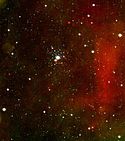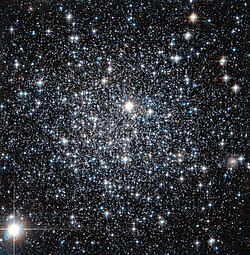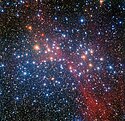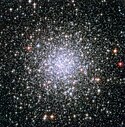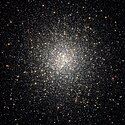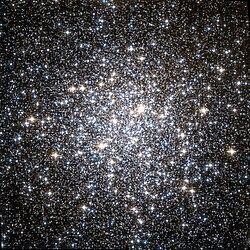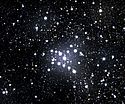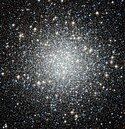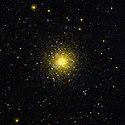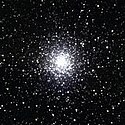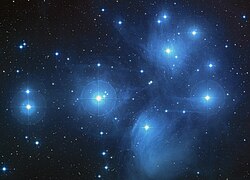Melottův katalog
Melottův katalog je astronomický katalog 245 objektů hlubokého vesmíru severní i jižní oblohy, který obsahuje otevřené a kulové hvězdokupy. Sestavil jej britský astronom Philibert Jacques Melotte v roce 1931.[1]
Podkladem pro sestavení tohoto katalogu byly fotografické snímky severní a jižní oblohy, které vytvořil anglický amatérský astronom John Franklin-Adams (1843–1912). Tyto snímky ukazovaly hvězdy až do 17. magnitudy a umožnily určit kulové hvězdokupy s úhlovým rozměrem větším než 3'. Melotte hvězdokupy rozdělil do čtyř skupin podle jejich stavby:
- Kulové hvězdokupy se středovým zhuštěním
- Volné (otevřené) hvězdokupy s dobře ohraničeným okrajem
- Volné hvězdokupy, často pouze několik hvězd, nepravidelný tvar
- Ostatní hvězdokupy
Většina objektů patřila do prvních dvou skupin.
Objekty Melottova katalogu jsou seřazeny podle rektascenze a označují se názvem Melotte nebo zkratkou Mel, za kterými následuje katalogové číslo z rozsahu 1 až 245 (např. Melotte 2 nebo Mel 2).[2] Tento katalog popsal některé hvězdokupy, které do té doby nebyly zapsány v žádném jiném katalogu, jako Asociace Alfa Persei, nebo především Melotte 111, což je známá hvězdokupa ve Vlasech Bereniky, jejíž pravá příslušnost mezi otevřené hvězdokupy byla potvrzena až v roce 1938. Na hvězdných mapách bývají otevřené hvězdokupy Melottova katalogu často označovány spíše jejich pořadovým číslem z Collinderova katalogu.
Seznam významných objektů
| Označení objektu | Název, číslo (NGC) | Běžný název (anglicky) | Obrázek | Typ objektu | Vzdálenost (světelné roky) | Souhvězdí | Vizuální magnituda |
|---|---|---|---|---|---|---|---|
| Mel 1 | NGC 104 (Caldwell 106) | (47 Tucanae) |  | Kulová hvězdokupa | 14 700 | Tukan | 4 |
| Mel 2 | NGC 188 (Caldwell 1) |  | Otevřená hvězdokupa | 4 800 | Cefeus | 8,1 | |
| Mel 3 | NGC 288 | Kulová hvězdokupa | 29 000 | Sochař | 8,1 | ||
| Mel 4 | NGC 362 (Caldwell 104) |  | Kulová hvězdokupa | 28 000 | Tukan | 4 | |
| Mel 7 | NGC 457 (Caldwell 13) | Človíček (Owl Cluster, ET Cluster) | Otevřená hvězdokupa | 6 500 | Kasiopeja | 6,4 | |
| Mel 8 | Messier 103 (NGC 581) |  | Otevřená hvězdokupa | 7 160 | Kasiopeja | 7,4 | |
| Mel 11 | NGC 663 (Caldwell 10) | Otevřená hvězdokupa | 6 850 | Kasiopeja | 7,1 | ||
| Mel 12 | NGC 752 (Caldwell 28) | Otevřená hvězdokupa | 1 300 | Andromeda | 5,7 | ||
| Mel 13 | NGC 869 (Caldwell 14) | Dvojitá hvězdokupa (Double Cluster, H & χ Persei) | Otevřená hvězdokupa | 6 800 | Perseus | 3,7 | |
| Mel 14 | NGC 884 (Caldwell 14) | Dvojitá hvězdokupa (Double Cluster, H & χ Persei) | Otevřená hvězdokupa | 7 600 | Perseus | 3,8 | |
| Mel 17 | Messier 34 (NGC 1039) | Otevřená hvězdokupa | 1 400 | Perseus | 5,2 | ||
| Mel 19 | NGC 1261 (Caldwell 87) |  | Kulová hvězdokupa | 53 100 | Hodiny | 8,3 | |
| Mel 20 | Melotte 20 | Asociace Alfa Persei (Alpha Persei Cluster) |  | Otevřená hvězdokupa | 620 | Perseus | 1,2 |
| Mel 22 | Plejády (Messier 45) | Plejády, Kuřátka, M45 (Pleiades, Seven Sisters) | Otevřená hvězdokupa | 440 | Býk | 1,6 | |
| Mel 25 | Hyády (Caldwell 41) | Otevřená hvězdokupa | 153 | Býk | 0,5 | ||
| Mel 30 | NGC 1851 (Caldwell 87) |  | Kulová hvězdokupa | 39 400 | Holubice | 7,1 | |
| Mel 34 | Messier 79 (NGC 1904) | Kulová hvězdokupa | 42 100 | Zajíc | 7,7 | ||
| Mel 36 | Messier 38 (NGC 1912) | Otevřená hvězdokupa | 4 200 | Vozka | 7,4 | ||
| Mel 37 | Messier 36 (NGC 1960) |  | Otevřená hvězdokupa | 4 100 | Vozka | 6,0 | |
| Mel 38 | Messier 37 (NGC 2099) |  | Otevřená hvězdokupa | 4 511 | Vozka | 5,6 | |
| Mel 41 | Messier 35 (NGC 2168) |  | Otevřená hvězdokupa | 2 800 | Blíženci | 5,1 | |
| Mel 47 | NGC 2244 (Caldwell 50) | součást mlhoviny Rozeta | Otevřená hvězdokupa | 5 200 | Jednorožec | 4,5 | |
| Mel 49 | NGC 2264 | Vánoční stromeček | Otevřená hvězdokupa | 2 180 | Jednorožec | 3,9 | |
| Mel 52 | Messier 41 (NGC 2287) |  | Otevřená hvězdokupa | 2 300 | Velký pes | 5,1 | |
| Mel 53 | NGC 2298 |  | Kulová hvězdokupa | 35 200 | Lodní záď | 9,3 | |
| Mel 58 | Messier 50 (NGC 2323) | Otevřená hvězdokupa | 3 000 | Jednorožec | 5,9 | ||
| Mel 64 | NGC 2360 (Caldwell 58) |  | Otevřená hvězdokupa | 6 155 | Velký pes | 7,2 | |
| Mel 65 | NGC 2362 (Caldwell 64) |  | Otevřená hvězdokupa | 4 800 | Velký pes | 4,1 | |
| Mel 68 | Messier 47 (NGC 2422) |  | Otevřená hvězdokupa | 1 600 | Lodní záď | 4,2 | |
| Mel 75 | Messier 46 (NGC 2437) | Otevřená hvězdokupa | 5 400 | Lodní záď | 6,1 | ||
| Mel 76 | Messier 93 (NGC 2447) |  | Otevřená hvězdokupa | 3 600 | Lodní záď | 6,2 | |
| Mel 78 | NGC 2477 (Caldwell 71) | Otevřená hvězdokupa | 3 600 | Lodní záď | 5,8 | ||
| Mel 80 | NGC 2506 (Caldwell 54) | Otevřená hvězdokupa | 11 300 | Jednorožec | 7,6 | ||
| Mel 82 | NGC 2516 (Caldwell 96) |  | Otevřená hvězdokupa | 1 300 | Lodní kýl | 3,8 | |
| Mel 85 | Messier 48 (NGC 2548) | Otevřená hvězdokupa | 2 500 | Hydra | 5,8 | ||
| Mel 88 | Messier 44 (NGC 2632) | Jesličky, M44 (Beehive Cluster, Praesepe) |  | Otevřená hvězdokupa | 577 | Rak | 3,7 |
| Mel 94 | Messier 67 (NGC 2682) |  | Otevřená hvězdokupa | 2 600 | Rak | 6,9 | |
| Mel 95 | NGC 2808 |  | Kulová hvězdokupa | 31 300 | Lodní kýl | 6,2 | |
| Mel 99 | NGC 3201 (Caldwell 79) | Kulová hvězdokupa | 16 000 | Plachty | 6,8 | ||
| Mel 102 | IC 2602 (Caldwell 102) | (Southern Pleiades, Theta Carinae Cluster) | Otevřená hvězdokupa | 479 | Lodní kýl | 1,9 | |
| Mel 103 | NGC 3532 (Caldwell 91) | (Wishing Well Cluster) |  | Otevřená hvězdokupa | 1 621 | Lodní kýl | 3,0 |
| Mel 107 | NGC 3766 (Caldwell 97) | (Pearl Cluster) |  | Otevřená hvězdokupa | 5 500 | Kentaur | 5,3 |
| Mel 111 | Melotte 111 (Collinder 256) | (Coma Star Cluster) |  | Otevřená hvězdokupa | 280 | Vlasy Bereniky | 1,8 |
| Mel 112 | NGC 4372 (Caldwell 108) |  | Kulová hvězdokupa | 18 900 | Moucha | 7,2 | |
| Mel 113 | Messier 68 (NGC 4590) |  | Kulová hvězdokupa | 33 600 | Hydra | 7,8 | |
| Mel 114 | NGC 4755 (Caldwell 94) | Klenotnice (Jewell Box Cluster) | Otevřená hvězdokupa | 6 400 | Jižní kříž | 4,2 | |
| Mel 115 | NGC 4833 |  | Kulová hvězdokupa | 21 500 | Moucha | 7,8 | |
| Mel 117 | Messier 53 (NGC 5024) |  | Kulová hvězdokupa | 58 400 | Vlasy Bereniky | 7,6 | |
| Mel 118 | Omega Centauri (NGC 5139) | (Omega Centauri) |  | Kulová hvězdokupa | 17 000 | Kentaur | 3,7 |
| Mel 119 | Messier 3 (NGC 5272) |  | Kulová hvězdokupa | 33 300 | Honicí psi | 6,2 | |
| Mel 121 | NGC 5286 (Caldwell 84) |  | Kulová hvězdokupa | 38 100 | Kentaur | 7,4 | |
| Mel 124 | NGC 5466 |  | Kulová hvězdokupa | 52 200 | Pastýř | 9,0 | |
| Mel 129 | IC 4499 |  | Kulová hvězdokupa | 61 300 | Rajka | 9,8 | |
| Mel 131 | NGC 5823 (Caldwell 88) | Otevřená hvězdokupa | 3 900 | Kružítko | 7,9 | ||
| Mel 133 | Messier 5 (NGC 5904) |  | Kulová hvězdokupa | 24 400 | Had | 5,7 | |
| Mel 139 | NGC 6025 (Caldwell 95) | Otevřená hvězdokupa | 2 700 | Jižní trojúhelník | 5,1 | ||
| Mel 140 | NGC 6067 |  | Otevřená hvězdokupa | 4 600 | Pravítko | 5,6 | |
| Mel 141 | NGC 6087 (Caldwell 89) | Otevřená hvězdokupa | 3 700 | Pravítko | 5,4 | ||
| Mel 142 | Messier 80 (NGC 6093) |  | Kulová hvězdokupa | 32 600 | Štír | 7,3 | |
| Mel 143 | NGC 6101 (Caldwell 107) |  | Kulová hvězdokupa | 50 200 | Rajka | 9,2 | |
| Mel 144 | Messier 4 (NGC 6121) |  | Kulová hvězdokupa | 7 200 | Štír | 7,3 | |
| Mel 145 | NGC 6124 (Caldwell 75) |  | Otevřená hvězdokupa | 1 500 | Štír | 5,8 | |
| Mel 148 | Messier 107 (NGC 6171) |  | Kulová hvězdokupa | 20 900 | Hadonoš | 7,8 | |
| Mel 150 | Messier 13 (NGC 6205) | (Hercules Globular Cluster) | Kulová hvězdokupa | 23 100 | Herkules | 5,8 | |
| Mel 151 | Messier 12 (NGC 6218) |  | Kulová hvězdokupa | 15 600 | Hadonoš | 6,7 | |
| Mel 153 | NGC 6231 (Caldwell 76) | (Northern Jewel Box) | Otevřená hvězdokupa | 5 900 | Štír | 2,6 | |
| Mel 157 | Messier 10 (NGC 6254) |  | Kulová hvězdokupa | 14 300 | Hadonoš | 6,6 | |
| Mel 159 | Messier 62 (NGC 6266) |  | Kulová hvězdokupa | 22 200 | Hadonoš | 6,4 | |
| Mel 160 | Messier 19 (NGC 6273) |  | Kulová hvězdokupa | 28 700 | Hadonoš | 6,8 | |
| Mel 167 | Messier 9 (NGC 6333) |  | Kulová hvězdokupa | 25 800 | Hadonoš | 7,8 | |
| Mel 168 | Messier 92 (NGC 6341) | Kulová hvězdokupa | 27 100 | Herkules | 6,4 | ||
| Mel 170 | NGC 6352 (Caldwell 81) |  | Kulová hvězdokupa | 18 300 | Oltář | 7,8 | |
| Mel 174 | NGC 6388 |  | Kulová hvězdokupa | 32 300 | Štír | 6,7 | |
| Mel 175 | Messier 14 (NGC 6402) | Kulová hvězdokupa | 30 300 | Hadonoš | 7,6 | ||
| Mel 176 | NGC 6397 (Caldwell 86) |  | Kulová hvězdokupa | 7 500 | Oltář | 5,3 | |
| Mel 178 | Messier 6 (NGC 6405) | Motýlí hvězdokupa (Butterfly Cluster) | Otevřená hvězdokupa | 1 600 | Štír | 4,2 | |
| Mel 179 | IC 4665 | Otevřená hvězdokupa | 1 150 | Hadonoš | 4,2 | ||
| Mel 180 | NGC 6441 |  | Kulová hvězdokupa | 37 800 | Štír | 7,2 | |
| Mel 183 | Messier 7 (NGC 6475) | (Ptolemy Cluster) |  | Otevřená hvězdokupa | 1 000 | Štír | 3,3 |
| Mel 184 | Messier 23 (NGC 6494) |  | Otevřená hvězdokupa | 2 150 | Střelec | 5,5 | |
| Mel 188 | Messier 21 (NGC 6531) | Otevřená hvězdokupa | 4 250 | Střelec | 5,9 | ||
| Mel 191 | NGC 6541 (Caldwell 78) |  | Kulová hvězdokupa | 24 400 | Jižní koruna | 6,3 | |
| Mel 192 | NGC 6544 |  | Kulová hvězdokupa | 9 800 | Střelec | 7,5 | |
| Mel 198 | Messier 16 (NGC 6611) | Orlí mlhovina (Eagle Nebula) | Otevřená hvězdokupa | 7 000 | Had | 6,0 | |
| Mel 200 | Messier 28 (NGC 6626) |  | Kulová hvězdokupa | 17 900 | Střelec | 6,8 | |
| Mel 201 | NGC 6633 | Otevřená hvězdokupa | 1 225 | Hadonoš | 4,6 | ||
| Mel 202 | Messier 69 (NGC 6637) |  | Kulová hvězdokupa | 28 700 | Střelec | 8,3 | |
| Mel 204 | Messier 25 (IC 4725) |  | Otevřená hvězdokupa | 2 000 | Střelec | 4,6 | |
| Mel 208 | Messier 22 (NGC 6656) |  | Kulová hvězdokupa | 10 400 | Střelec | 5,2 | |
| Mel 210 | IC 4756 | Otevřená hvězdokupa | 1 580 | Hadonoš | 4,6 | ||
| Mel 211 | Messier 70 (NGC 6681) |  | Kulová hvězdokupa | 29 300 | Střelec | 7,8 | |
| Mel 212 | Messier 26 (NGC 6694) |  | Otevřená hvězdokupa | 5 000 | Štít | 8,0 | |
| Mel 213 | Messier 11 (NGC 6705) | Divoká kachna (Wild Duck Cluster) |  | Otevřená hvězdokupa | 6 000 | Štít | 5,8 |
| Mel 216 | Messier 54 (NGC 6715) |  | Kulová hvězdokupa | 86 400 | Střelec | 7,6 | |
| Mel 217 | NGC 6723 |  | Kulová hvězdokupa | 28 400 | Střelec | 7,0 | |
| Mel 218 | NGC 6752 (Caldwell 93) |  | Kulová hvězdokupa | 13 000 | Páv | 5,3 | |
| Mel 220 | Messier 56 (NGC 6779) |  | Kulová hvězdokupa | 30 600 | Lyra | 8,4 | |
| Mel 221 | Messier 55 (NGC 6809) | Kulová hvězdokupa | 17 600 | Střelec | 6,3 | ||
| Mel 226 | Messier 71 (NGC 6838) |  | Kulová hvězdokupa | 68 100 | Šíp | 8,6 | |
| Mel 228 | Messier 75 (NGC 6864) |  | Kulová hvězdokupa | 13 000 | Střelec | 8,4 | |
| Mel 230 | NGC 6934 (Caldwell 47) |  | Kulová hvězdokupa | 50 900 | Delfín | 8,8 | |
| Mel 233 | Messier 72 (NGC 6981) |  | Kulová hvězdokupa | 55 400 | Vodnář | 9,3 | |
| Mel 234 | Messier 15 (NGC 7078) |  | Kulová hvězdokupa | 33 900 | Pegas | 6,3 | |
| Mel 235 | Messier 2 (NGC 7089) |  | Kulová hvězdokupa | 37 500 | Vodnář | 6,5 | |
| Mel 236 | Messier 39 (NGC 7092) | Otevřená hvězdokupa | 825 | Labuť | 4,6 | ||
| Mel 237 | Messier 30 (NGC 7099) |  | Kulová hvězdokupa | 36 400 | Kozoroh | 6,9 | |
| Mel 240 | NGC 7243 (Caldwell 16) |  | Otevřená hvězdokupa | 2 600 | Ještěrka | 6,4 | |
| Mel 243 | Messier 52 (NGC 7654) |  | Otevřená hvězdokupa | 5 000 | Kasiopeja | 6,9 | |
| Mel 245 | NGC 7789 | Otevřená hvězdokupa | 7 620 | Kasiopeja | 6,7 |
Odkazy
Reference
V tomto článku byl použit překlad textu z článku Catalogo Melotte na italské Wikipedii.
- ↑ MELOTTE, P. J. A Catalogue of Star Clusters shown on Franklin-Adams Chart Plates. S. 175. Memoirs of the Royal Astronomical Society [online]. 1915 [cit. 2016-09-20]. Roč. 60, s. 175. Dostupné online. Bibcode 1915MmRAS..60..175M. (anglicky)
- ↑ Simbad: Dictionary of Nomenclature of Celestial Objects [online]. Centre de Données astronomiques de Strasbourg [cit. 2016-09-20]. Dostupné online. (anglicky)
Související články
- Seznam objektů v Messierově katalogu
- Caldwellův katalog
- Collinderův katalog
- Index Catalogue
- New General Catalogue
Externí odkazy
 Obrázky, zvuky či videa k tématu Melottův katalog na Wikimedia Commons
Obrázky, zvuky či videa k tématu Melottův katalog na Wikimedia Commons - Melottův katalog na stránkách DeepSkyPedia
Média použitá na této stránce
Messier 70 globular cluster by Hubble Space Telescope; 3.32′ view
Autor: VST image of the giant globular cluster Omega Centauri, Licence: CC BY 4.0
VST image of the giant globular cluster Omega Centauri
Autor: Own work, Licence: CC BY-SA 3.0
Color rendering is done by by Aladin-software (2000A&AS..143...33B.)
Messier 56 by Hubble Space Telescope. 3.6′ view
Autor: http://sternwarte-kempten.de/, Licence: CC BY 3.0
Open cluster Melotte 111, or Coma Star Cluster.
Autor: Miguel Garcia, Licence: CC BY-SA 4.0
Open Cluster M38, 18 x 300 seconds exposures, Takahashi 102 f/6 refractor. Feb 19, 2015. Taken in Weston, FL
Globular Star Cluster M4, NGC 6121.
Autor: Own work, Licence: CC BY-SA 3.0
Color rendering is done by by Aladin-software (2000A&AS..143...33B.)
Autor: ESO, Licence: CC BY 4.0
Colour-composite image of the globular cluster NGC 3201, obtained with the WFI instrument on the ESO/MPG 2.2-m telescope at La Silla. Globular clusters are large aggregates of stars, that can contain up to millions of stars. They are among the oldest objects observed in the Universe and were presumably formed at about the same time as the Milky Way Galaxy, in the early phase after the Big Bang. This particular globular cluster is located about 16 000 light-years away towards the Southern Vela constellation. The data were obtained as part of the ESO Imaging Survey (EIS), a public survey being carried out by ESO and member states, in preparation for the VLT First Light. The original image and astronomical data can be retrieved from the EIS Pre-Flames Survey Data Release pages, where many other nice images are also available.
Original caption of image: "This photograph from NASA's Spitzer Space Telescope shows the young star cluster NGC 2362. By studying it, astronomers found that gas giant planet formation happens very rapidly and efficiently, within less than 5 million years, meaning that Jupiter-like worlds experience a growth spurt in their infancy."
Hubble image of globular cluster NGC 6101
The open cluster Messier 47
NGC 6544 by Hubble space telescope
Autor: Till Credner und Sven Kohle, Calar Alto Observatory, Licence: CC BY-SA 2.0 de
Globular Star Cluster M 71
Autor: Jose Luis Martinez, Licence: CC BY-SA 4.0
Cúmulo abierto M46, también conocido como NGC 2437
Autor: Credit Line and Copyright Adam Block/Mount Lemmon SkyCenter/University of Arizona, Licence: CC BY-SA 3.0 us
NGC 5466
Picture Details:
Optics 32-inch Schulman Telescope (RC Optical Systems), Acquired remotely Camera SBIG STX 16803 CCD Camera Filters AstroDon Gen II Dates May 2013 Location Mount Lemmon SkyCenter Exposure RGB = 90:90:90 minutes Acquisition ACP Observatory Control Software (DC-3 Dreams), Maxim DL/CCD (Cyanogen), FlatMan XL (Alnitak) Processing CCDStack (CCDWare), Photoshop CC (Adobe), PixInsight Credit Line and Copyright Adam Block/Mount Lemmon SkyCenter/University of Arizona.
Autor: C messier, Licence: CC BY-SA 4.0
The open cluster Messier 23. Photographed through a 36mm eyepiece from a SKYWATCHER DOBSONIAN 8″ telescope. Contrast has been enhaced.
Autor: Credit: ESA/Hubble & NASA, Licence: CC BY 3.0
IC 4499: A globular cluster’s age revisited
This new NASA/ESA Hubble Space Telescope image shows the globular cluster IC 4499.
Globular clusters are big balls of old stars that orbit around their host galaxy. It has long been believed that all the stars within a globular cluster form at the about same time, a property which can be used to determine the cluster's age. For more massive globulars however, detailed observations have shown that this is not entirely true — there is evidence that they instead consist of multiple populations of stars born at different times. One of the driving forces behind this behaviour is thought to be gravity: more massive globulars manage to grab more gas and dust, which can then be transformed into new stars.
IC 4499 is a somewhat special case. Its mass lies somewhere between low-mass globulars, which show a single generation build-up, and the more complex and massive globulars which can contain more than one generation of stars. By studying objects like IC 4499 astronomers can therefore explore how mass affects a cluster's contents. Astronomers found no sign of multiple generations of stars in IC 4499 — supporting the idea that less massive clusters in general only consist of a single stellar generation.
Hubble observations of IC 4499 have also helped to pinpoint the cluster's age: observations of this cluster from the 1990s suggested a puzzlingly young age when compared to other globular clusters within the Milky Way. However, since those first estimates new Hubble data been obtained, and it has been found to be much more likely that IC 4499 is actually roughly the same age as other Milky Way clusters at approximately 12 billion years old.
Credit:
ESA/Hubble & NASA
About the Object
Name: IC 4499
Type: • Milky Way : Star : Grouping : Cluster : Globular
• X - Stars Images/Videos
Distance: 55000 light years
Colours & filters Band Wavelength Telescope
Optical V 606 nm Hubble Space Telescope WFC3 Infrared I 814 nm Hubble Space Telescope WFC3.
Autor: ESO/G. Beccari, Licence: CC BY 4.0
The colourful star cluster NGC 3532
The MPG/ESO 2.2-metre telescope at ESO’s La Silla Observatory in Chile captured this richly colourful view of the bright star cluster NGC 3532. Some of the stars still shine with a hot bluish colour, but many of the more massive ones have become red giants and glow with a rich orange hue.
Credit:
ESO/G. Beccari
About the Object
Name: NGC 3532
Type: • Milky Way : Star : Grouping : Cluster : Open
• X - Star Clusters
Distance: 1300 light years
Constellation: Carina
Colours & filters Band Telescope
Optical B MPG/ESO 2.2-metre telescope WFI Optical V MPG/ESO 2.2-metre telescope WFI Optical H-alpha MPG/ESO 2.2-metre telescope WFI Infrared I MPG/ESO 2.2-metre telescope WFI.
Autor: European Southern Observatory, Licence: CC BY-SA 3.0
The globular cluster NGC 6397, located at a distance of approx. 7,200 light-years in the southern constellation Ara. It has undergone a "core collapse" and the central area is very dense. It contains about 400,000 stars and its age (based on evolutionary models) is 13,400 ± 800 million years. The photo is a composite of exposures in the B-, V- and I-bands obtained in the frame of the Pilot Stellar Survey with the Wide-Field-Imager (WFI) camera at the 2.2-m ESO/MPI telescope at the ESO La Silla Observatory. It was prepared and provided by the ESO Imaging Survey team. The spikes seen at some of the brighter stars are caused by the effect of overexposure (CCD "bleeding").
Colours & filters
Band Telescope
Optical B MPG/ESO 2.2-metre telescope WFI
Optical V MPG/ESO 2.2-metre telescope WFI
Autor: sebastien lebrigand from crépy en valois, FRANCE, Licence: CC BY-SA 2.0
ngc 752
en:Messier 54 globular cluster by en:Hubble Space Telescope; 3.5′ view
en:Messier 22 globular cluster by en:Hubble Space Telescope; 3.5′ view
Autor: HST / Fabian RRRR (talk), Licence: CC BY-SA 3.0
Color rendering is done by by Aladin-software (2000A&AS..143...33B.)
(c) ESA/Hubble, CC BY 4.0
This brilliant image of Messier 30 (M 30) was taken by Hubble's Advanced Camera for Surveys (ACS). Messier 30 formed 13 billion years ago and was discovered in 1764 by Charles Messier. Located about 28000 light-years away from Earth, this globular cluster — a dense swarm of several hundred thousand stars — is about 90 light-years across.
Although globular clusters such as this one are mainly populated by old stars, the crowded field of stars leads to some old stars apparently reclaiming their youth in the form of blue stragglers. Researchers using data from Hubble's now-retired Wide Field Planetary Camera 2 (WFPC2) have identified two types of blue stragglers in Messier 30: those that form in near head-on collisions with one another and those that are in twin (or binary) systems where the less massive star siphons "life-giving" hydrogen from its more massive companion.The dazzling stars in Messier 15 look fresh and new in this image from the NASA/Hubble Space Telescope, but they are actually all roughly 13 billion years old, making them some of the most ancient objects in the Universe. Unlike another recent Hubble Picture of the Week, which featured the unusually sparse cluster Palomar 1, Messier 15 is rich and bright despite its age.
Messier 15 is a globular cluster — a spherical conglomeration of old stars that formed together from the same cloud of gas, found in the outer reaches of the Milky Way in a region known as the halo and orbiting the Galactic Centre. This globular lies about 35 000 light-years from the Earth, in the constellation of Pegasus (The Flying Horse).
Messier 15 is one of the densest globulars known, with the vast majority of the cluster’s mass concentrated in the core. Astronomers think that particularly dense globulars, like this one, underwent a process called core collapse, in which gravitational interactions between stars led to many members of the cluster migrating towards the centre.
Messier 15 is also the first globular cluster known to harbour a planetary nebula, and it is still one of only four globulars known to do so. The planetary nebula, called Pease 1, can be seen in this image as a small blue blob to the lower left of the globular’s core.
This picture was put together from images taken with the Wide Field Channel of Hubble's Advanced Camera for Surveys. Images through yellow/orange (F606W, coloured blue) and near-infrared (F814W, coloured red) filters were combined. The total exposure times were 535 s and 615 s respectively and the field of view is 3.4 arcminutes across.Messier 72 - globular cluster. The image was produced by en:WikiSky's image cutout tool out of en:Hubble Space Telescope data. Source url: [1] Hubble's source: [2].
Autor: Till Credner und Sven Kohle, Observatorium Hoher List, Licence: CC BY-SA 2.0 de
Globular Star Cluster M 10
Messier 69 (M69) globular cluster - photo taken by Hubble Space Telescope.
Autor: Donald Pelletier, Licence: CC BY-SA 4.0
Image créée à l'aide du logiciel Aladin Sky Atlas du Centre de Données astronomiques de Strasbourg et des données de DSS (Digitized Sky Survey).
This Hubble Space Telescope (HST) image of a dense swarm of stars shows the central region of the globular cluster NGC 2808 and its 3 generations of stars.
Autor: Fabian RRRR, Licence: CC BY-SA 3.0
Color rendering is done by by Aladin-software (2000A&AS..143...33B.)
Hubble image of globular cluster NGC 6352
Autor: HST / Fabian RRRR (talk), Licence: CC BY-SA 3.0
Color rendering is done by by Aladin-software (2000A&AS..143...33B.)
The open cluster Messier 41
Hubble image of globular cluster NGC 2298
Autor: ESO, Licence: CC BY 4.0
This spectacular group of young stars is the open star cluster NGC 3766 in the constellation of Centaurus (The Centaur). Very careful observations of these stars by a group from the Geneva Observatory using the Swiss 1.2-metre Leonhard Euler Telescope at ESO’s La Silla Observatory in Chile have shown that 36 of the stars are of a new and unknown class of variable star. This image was taken with the MPG/ESO 2.2-metre telescope at the La Silla Observatory.
Messier object 9 - globular cluster in Ophiucus constellation by Hubble space telescope
Autor: Hewholooks, Licence: CC BY-SA 3.0
Open Star Cluster NGC663 in Cassiopeia
The globular cluster Messier 5, shown here in this NASA/ESA Hubble Space Telescope image, is one of the oldest belonging to the Milky Way. The majority of its stars formed more than 12 billion years ago, but there are some unexpected newcomers on the scene, adding some vitality to this aging population.
Stars in globular clusters form in the same stellar nursery and grow old together. The most massive stars age quickly, exhausting their fuel supply in less than a million years, and end their lives in spectacular supernovae explosions. This process should have left the ancient cluster Messier 5 with only old, low-mass stars, which, as they have aged and cooled, have become red giants, while the oldest stars have evolved even further into blue horizontal branch stars.
Yet astronomers have spotted many young, blue stars in this cluster, hiding amongst the much more luminous ancient stars. Astronomers think that these laggard youngsters, called blue stragglers, were created either by stellar collisions or by the transfer of mass between binary stars. Such events are easy to imagine in densely populated globular clusters, in which up to a few million stars are tightly packed together.
Messier 5 lies at a distance of about 25 000 light-years in the constellation of Serpens (The Snake). This image was taken with Wide Field Channel of Hubble’s Advanced Camera for Surveys. The picture was created from images taken through a blue filter (F435W, coloured blue), a red filter (F625W, coloured green) and a near-infrared filter (F814W, coloured red). The total exposure times per filter were 750 s, 400 s and 567 s, respectively. The field of view is about 2.6 arcminutes across.Autor: Hewholooks, Licence: CC BY-SA 3.0
NGC 7789 in Cassiopeia Taken with Modded 350D and Orion ED80 Telescope
Autor: Own work, Licence: CC BY-SA 3.0
Color rendering is done by by Aladin-software (2000A&AS..143...33B.)
Autor: Guillermo Abramson, Licence: CC BY 3.0
Open cluster NGC 2477. Stack of 8x60sec, ISO 400, Canon XTi at prime focus of telescope Meade LX10, f=2000mm reduced to 1250 @f/6.3. Stacked in DeepSkyStacker. Taken from Bariloche, Argentina (41S 71W).
Autor: C messier, Licence: CC0
NGC 6231 photographed through a 36mm eyepiece from a SKYWATCHER DOBSONIAN 8″ telescope.
Praesepe: the open cluster Messier 44
Image of M52 Credit: Atlas Image [or Atlas Image mosaic] obtained as part of the Two Micron All Sky Survey (2MASS), a joint project of the University of Massachusetts and the Infrared Processing and Analysis Center/California Institute of Technology, funded by the National Aeronautics and Space Administration and the National Science Foundation.
Autor: Roberto Mura, Licence: CC BY-SA 3.0
Messier 7, open cluster in Scorpius. Image taken from Stellarium.
Autor: HST / Fabian RRRR (talk), Licence: CC BY-SA 3.0
Color rendering is done by by Aladin-software (2000A&AS..143...33B.)
NGC 6388 by Hubble space telescope
Autor: Donald Pelletier, Licence: CC BY-SA 4.0
Image créée à l'aide du logiciel Aladin Sky Atlas du Centre de Données astronomiques de Strasbourg et des données de DSS (Digitized Sky Survey).
Autor: Credit Line and Copyright Adam Block/Mount Lemmon SkyCenter/University of Arizona, Licence: CC BY-SA 3.0 us
M92
Picture Details:
Optics 24-inch RC Optical Systems Telescope Camera SBIG STL11000 CCD Camera Filters Custom Scientific Dates May 30th 2009 Location Mount Lemmon SkyCenter Exposure LRGB = 25:25:25:25 minutes Acquisition ACP Observatory Control Software (DC-3 Dreams),TheSky (Software Bisque), Maxim DL/CCD (Cyanogen) Processing CCDStack (CCDWare), Mira (MiraMetrics), Photoshop CS3 (Adobe) Guest Astronomers: May 2009 CCD Image Processing ParticipantsCredit Line and Copyright Adam Block/Mount Lemmon SkyCenter/University of Arizona
Autor: Roberto Mura, Licence: CC BY-SA 3.0
Alpha Persei Cluster, screenshot taken from Stellarium, a freeware astronomic simulation software.
Autor: Ljubinko Jovanovic, Licence: CC BY-SA 3.0
NGC 2264 (Within the nebula where are Cone nebula, Christmas Tree Cluster and Fox Fur Nebula)
Autor: ESA/Hubble & NASA, Licence: CC BY 3.0
Thousands and thousands of brilliant stars make up this globular cluster, Messier 53, captured with crystal clarity in this image from the NASA/ESA Hubble Space Telescope. Bound tightly by gravity, the cluster is roughly spherical and becomes denser towards its heart.
These enormous sparkling spheres are by no means rare, and over 150 exist in the Milky Way alone, including Messier 53. It lies on the outer edges of the galaxy, where many other globular clusters are found, almost equally distant from both the centre of our galaxy and the Sun. Although they are relatively common, the famous astronomer William Herschel, not at all known for his poetic nature, once described a globular cluster as “one of the most beautiful objects I remember to have seen in the heavens”, and it is clear to see why.
Globular clusters are much older and larger than open clusters, meaning they are generally expected to contain more old red stars and fewer massive blue stars. But Messier 53 has surprised astronomers with its unusual number of a type of star called blue stragglers.
These youngsters are rebelling against the theory of stellar evolution. All the stars in a globular cluster are expected to form around the same time, so they are expected follow a specific trend set by the age of the cluster and based on their mass. But blue stragglers don’t follow that rule; they appear to be brighter and more youthful than they have any right to be. Although their precise nature remains mysterious these unusual objects are probably formed by close encounters, possibly collisions, between stars in the crowded centres of globular clusters.
This picture was put together from visible and infrared exposures taken with the Wide Field Channel of Hubble's Advanced Camera for Surveys.The field of view is approximately 3.4 arcminutes across.Ultraviolet image of the globular cluster NGC 1851 in the southern constellation Columba.
Autor: Andrew Cooper acooper@pobox.com, Licence: CC BY-SA 3.0
Open clusters NGC 869 and NGC 884
The open cluster IC 2602 in the constellation Carina. Computer image created with the astronomy software Perseus.
Messier 62 globular cluster by Hubble Space Telescope; 1.65′ view
The Pleiades, an open cluster consisting of approximately 3,000 stars at a distance of 400 light-years (120 parsecs) from Earth in the constellation of Taurus. It is also known as ‘The Seven Sisters’, or the astronomical designations NGC 1432/35 and M45.
This stellar swarm is M80 (NGC 6093), one of the densest of the 147 known globular star clusters in the Milky Way galaxy. Located about 28,000 light-years from Earth, M80 contains hundreds of thousands of stars, all held together by their mutual gravitational attraction. Globular clusters are particularly useful for studying stellar evolution, since all of the stars in the cluster have the same age (about 12 billion years), but cover a range of stellar masses. Every star visible in this image is either more highly evolved than, or in a few rare cases more massive than, our own Sun. Especially obvious are the bright red giants, which are stars similar to the Sun in mass that are nearing the ends of their lives.
(c) Vanderbei na projektu Wikipedie v jazyce angličtina, CC BY 2.5
Image of M13 taken by Robert J. Vanderbei using a 10" Ritchey-Chretien telescope and a Starlight Express SXV-H9 CCD camera.
(c) Michael L. Umbricht / Ladd Observatory, CC BY-SA 3.0
Open cluster en:w:NGC 188. Taken with a 16" Meade LX200 telescope and SBIG ST-L digital camera at the Barus & Holley Observatory in Providence, RI, USA with a Clear filter. A 180 second exposure taken 2008-11-11T00:24:23 UTC.













